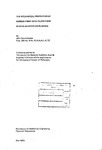The Mechanical Properties of Carbon Fibre With Glass Fibre Hybrid Reinforced Plastics
| dc.contributor.author | Summerscales, John | |
| dc.contributor.other | School of Engineering, Computing and Mathematics | en_US |
| dc.date.accessioned | 2013-02-11T09:08:08Z | |
| dc.date.available | 2013-02-11T09:08:08Z | |
| dc.date.issued | 1983 | |
| dc.identifier | N/A | en_US |
| dc.identifier.uri | http://hdl.handle.net/10026.1/1288 | |
| dc.description | Merged with duplicate record 10026.1/2475 on 15.03.2017 by CS (TIS) | |
| dc.description.abstract |
Fibre composite hybrid materials are generally plastics reinforced with two different fibre species. The combination of these three materials (in this thesis they are carbon fibres, glass fibres and polyester resin) allows a balance to be achieved between the properties of the two monofibre composites. Over the fifteen years since the introduction of continuous carbon fibre as a reinforcement, there has been considerable speculation about the "hybrid effect", a synergistic strengthening of reinforced plastics with two fibres when compared with the strength predicted from a weighted average from the component composites. A new equation is presented which predicts the extent of the hybrid effect. Experiments with a variety of carbon-glass hybrids were undertaken to examine the validity of the theory and the effect of the degree of inter-mixing of the fibres. The classification and quantification of the hybrid microstructures was examined with a view to crosscorrelation of the intimacy of mixing and the strength. Mechanical tests were monitored with acoustic emission counting and acoustic emission amplitude distribution equipment. Some specimens were subjected to one thermal cycle to liquid nitrogen temperature prior to testing. Fracture surfaces were examined in the scanning electron microscope. Numerical analysis by finite element methods was attempted. A constant strain triangular element was used initially, but in the later analyses the PAFEC anisotropic isoparametric quadrilateral elements were used. The system was adapted so that a \Ir singularity could be modelled, and post processor software was written to allow nodal averaging of the stresses and the presentation of this data graphically as stress contour maps. | en_US |
| dc.language.iso | en | en_US |
| dc.publisher | University of Plymouth | en_US |
| dc.title | The Mechanical Properties of Carbon Fibre With Glass Fibre Hybrid Reinforced Plastics | en_US |
| dc.type | Thesis | |
| plymouth.version | Full version | en_US |
| dc.identifier.doi | http://dx.doi.org/10.24382/4969 | |
| dc.identifier.doi | http://dx.doi.org/10.24382/4969 |
Files in this item
This item appears in the following Collection(s)
-
01 Research Theses Main Collection
Research Theses Main


